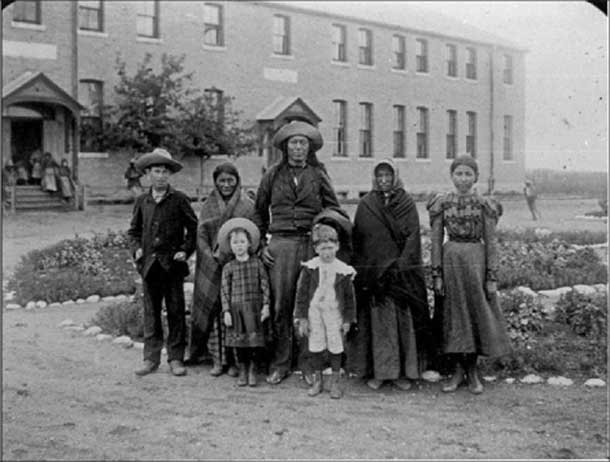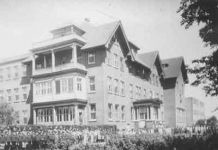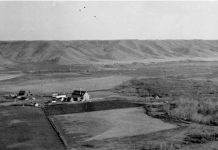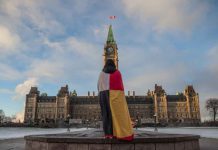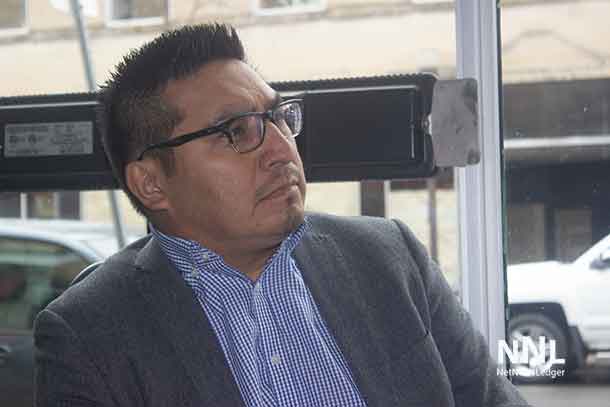 STANDOFF – Aboriginal news – On July 11, 2011, Prime Minister Harper was named an honorary Chief of the First Nations Blood Tribe of Alberta. Persons are selected as honorary members of the Kainai Chieftainship based on contributions to the Blood Tribe and to the cause of native people throughout the world. For Prime Minister Harper, the Chieftainship ceremony was requested by Blood Tribe Chief Charles Weasel Head in response to the heartfelt apology in 2008 by the Prime Minister to former students of Indian Residential Schools.
STANDOFF – Aboriginal news – On July 11, 2011, Prime Minister Harper was named an honorary Chief of the First Nations Blood Tribe of Alberta. Persons are selected as honorary members of the Kainai Chieftainship based on contributions to the Blood Tribe and to the cause of native people throughout the world. For Prime Minister Harper, the Chieftainship ceremony was requested by Blood Tribe Chief Charles Weasel Head in response to the heartfelt apology in 2008 by the Prime Minister to former students of Indian Residential Schools.
There are currently 40 living individuals carrying a Kanai Chieftainship.
“It is a great privilege to be named an honorary Chief of Alberta’s Blood Tribe, a strong and proud First Nation,” said Prime Minister Harper. “I am particularly proud of this honour given it recognizes the efforts that our Government has been taking to help preserve the rich culture and heritage of First Nations in Canada while also investing in the future of Aboriginal peoples.”
The Ceremony: The ceremony included a Grand Entry with dancers, drummers, Council members, Elders and other participants. They will walk to the Red Crow Park powwow area and the Chief and Council will greet the honoured recipient. An opening prayer will be done by a Blood Tribe Elder and there will be a welcoming address by Chief Charles Weasel Head.
The capture ceremony involved a traditional, symbolic “capture” into the Blood Tribe, there was a smudge, where the participants remove any jewellery including watches, rings, and glasses. Chief Charlie Weasel Head and the Blood Tribe Council asked veteran Master Corporal Melissa Whitegrass to conduct the “Capture Ceremony.” She lead the induction to the Kainai Chieftainship, provide the Prime Minister with a headdress and an aboriginal name, Chief Speaker or Ninayh’poaskin in Blackfoot.
Master Corporal Whitegrass, a member of 18 Air Defence Regiment, a Canadian Forces Reserve unit, wore her Canadian Forces dress uniform during the ceremony. Master Corporal Whitegrass was injured during a vehicle-borne improvised explosive device attack in Kabul, where she was serving as a Reservist on 18 May 2010, when another Canadian, Colonel Geoff Parker was killed.
The ceremony took place in a teepee and the participants were seated on a buffalo robe. At this point, there was a painting of the face and hands with the sacred red ochre, a giving of the Blackfoot Name, followed by the ceremony bestowing the Honorary Kainai Chieftainship with a headdress; the Elder explained the process and significance of the name during the headdress presentation.
After the ceremony, there was an acceptance speech. Gifts were presented by Chief and Council and the Kainai Chieftainship Society. Kainai Chieftainship President Gerald Conaty conducted scroll presentations and Chief Charles Weasel Head delivered closing remarks.
Honorary Chiefs are expected to help promote cultural pride of the Blackfoot and Kainai and all First Nations. They must maintain the headdress with the highest respect and be an available resource to First Nations.
“My family and I are deeply grateful for this gift and I will carry my Blood name, Chief Speaker, with great joy and pride,” concluded the Prime Minister.
Blood Tribe: The Blood Tribe, Peigan and Siksika tribes form the Blackfoot Confederacy and are considered to be the oldest residents of the western prairie region. The Blackfoot speaking peoples were one of the last First Nations to enter into treaty with the Americans in 1855, through the Lamebull Treaty. On the British side of the 49th parallel, the tribes did not enter into treaty with the British Crown until 1877 through Treaty 7. Today, the Blood Tribe has the largest reserve in Canada consisting of 1,430 square kilometres located in southern Alberta, with a registered population of 11,074, on and off reserve.

